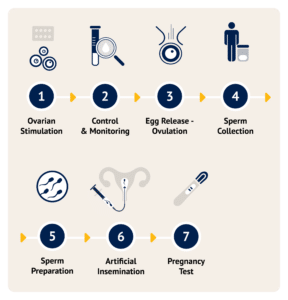Proudly part of the City Fertility Network
Proudly part of the City Fertility Network
Request an appointment with one of our specialists.Book an Initial Consultation
Artificial insemination, also known as Intrauterine Insemination (IUI), is a fertility procedure in which washed and concentrated sperm is directly inserted into a woman’s uterus around the time of ovulation to improve the chances of conceiving.
Your fertility specialist may recommend IUI as a less invasive and more affordable introduction to fertility treatment or when donor sperm is required. IUI treatment is not suitable for everyone and depends on many factors. It may be recommended for couples experiencing any of the following:
Artificial Insemination or IUI treatment is not recommended for:
Donor sperm can also used for artificial insemination, which can also be known as donor insemination (DI) cycles. This is suitable for single women, same-sex couples or in cases where a male partner is azoospermic (no sperm produced).
Read our fact sheet about donor insemination to learn more about this treatment option.

The IUI procedure involves the use of fresh or frozen sperm from a partner or donor. The artificial insemination process includes the following steps:
Ovarian stimulation involves taking oral medication or follicle-stimulating hormone (FSH) injections at the start of your period to stimulate the ovaries and encourage the growth of multiple follicles containing eggs.
Your fertility specialist will closely monitor your response during ovarian stimulation with ultrasounds and/or blood tests. This is important as ovulation induction medication is powerful and may need to be adjusted to control the number of follicles thus reducing the risk of a multiple pregnancy.
When the follicle(s) reach a certain size a Human Chorionic Gonadotrophin (hCG) injection (often referred to as a ‘the trigger injection’) is administered in preparation for intercourse or intra-uterine insemination (IUI).
IUI treatment can use fresh sperm or frozen sperm from a partner or a sperm donor. No matter what sperm is being used, a washed concentrated sample of motile sperm will be used for insemination.
The sperm sample is prepared in a way that concentrates the motile sperm in a small volume. By removing the seminal plasma, debris and sub-optimal sperm, the final preparation allows for the best quality sperm to be used for the IUI.
The final stage of IUI treatment is the insertion of the prepared sperm directly into the woman’s uterus. Your fertility specialist will use a speculum and a disposable catheter to bypass the cervix. Insemination is a simple procedure and just takes a few minutes – many women describe it as being like a Pap smear.
The benefits of the insemination process are:
The final stage of IUI is called the luteal phase and it’s the two weeks between insemination and the pregnancy test. Many people find this to be the most difficult time to endure. Whilst it’s an exciting and optimistic time, it can often be emotionally charged with expectation and anxiety. You will be encouraged to eat well, stay hydrated and keep busy while you wait for your pregnancy blood test.
There are three IUI treatment options:
The best pregnancy results are achieved using the CC or FSH treatment options. IUI treatment is not suitable for everyone. This treatment depends on various factors and your fertility specialist will determine if this is a suitable treatment for you.
Your pregnancy test is performed two weeks after the insemination. The time between the insemination and your pregnancy test is often emotionally charged with expectation and anxiety. We understand that this can be a difficult time and encourage you to contact your fertility clinic for support.
If your artificial insemination or IUI procedure is unsuccessful, we encourage you to have a follow-up appointment with your fertility specialist. At this appointment, plans for further treatment can be made and any questions answered.
In vitro fertilisation (IVF) has a much higher pregnancy success rate than IUI with an average pregnancy rate of approximately 42.5%*. It is generally recommended that you move to IVF if IUI has been unsuccessful after two. Your fertility specialist will discuss treatment with you at follow-up consultations.
We understand that every fertility journey is different. At City Fertility we tailor our fee schedule to your individualised treatment plan, created for you, by your Fertility Specialist.
IUI is often used as an early intervention fertility treatment and is not suitable for everyone. It’s covered by Medicare and the cost is $1,050 with your estimated out-of-pocket cost (after Medicare rebate) of $975.
You can learn more about our fertility treatment costs and Medicare rebates here: Fertility Treatment Prices | City Fertility.
IUI success rates differ with the use of donor sperm and sperm used from a husband/partner. There are several reasons for this depending on your individual circumstances and your fertility specialist will discuss this with you.
IUI success with partner or husband’s sperm
Under 39 years is 10%*
IUI success with donor sperm
Under 35 years is 21.4% and 35 – 39 years is 15.2%*
It is generally recommended that you progress to IVF if IUI has been unsuccessful after two attempts. In vitro fertilisation (IVF) has a much higher pregnancy success rate than IUI. City Fertility’s average success rate is 42.5%* (based on City Fertility national data collected in 2024 from all clinics in the age group under 40 years).
With Medicare’s assistance, fertility treatment is now more affordable. IUI is covered by Medicare. You can learn more about Medicare rebates here: Medicare Rebates for Fertility Treatment.
The key difference between IUI and IVF is where the process of fertilisation takes place. IUI takes place inside the uterus, relying on natural fertilisation for the egg and sperm to meet on their own. IVF happens outside of the uterus in a controlled laboratory with more intervention.
You can learn more about the difference here: IUI and IVF: What’s the difference? | City Fertility.
Potential risks and side effects associated with IUI include:
Request an appointment with one of our specialists.Make your appointment